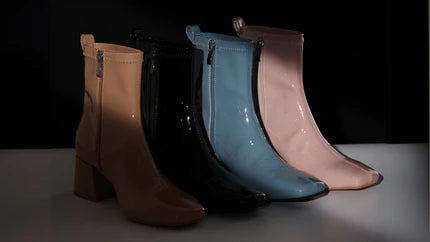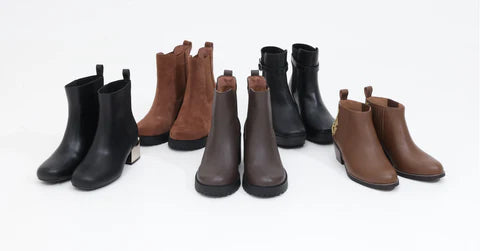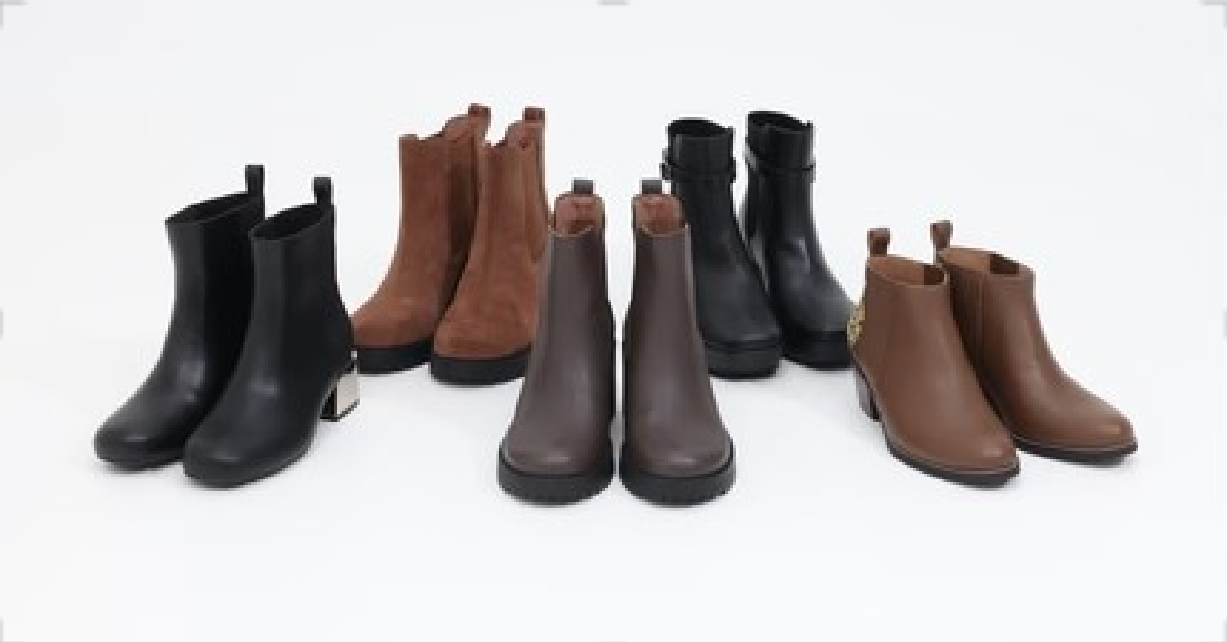Slipping on a new pair of boots should feel just right – like they were made for your feet. Once you find the right balance between comfort and fit, you won't have to worry about your feet while you walk. Let’s break it down into simple terms: your toes need wiggle space, your heels need to stay put, and your arches need the kind of support that keeps you going all day long.
We'll show you how to find boots that fit perfectly so that every step you take is comfortable.
The Right Boot Size Matters
Wearing boots that fit well is crucial in various ways:
- The right size keeps your toes comfortable and allows them to wiggle, which avoids cramps and blisters.
- A snug heel means less sliding and fewer chances of tripping or getting hurt.
- Proper arch support can prevent leg and back pain by fitting the natural curve of your foot.
- Boots that fit just right make standing or walking for long hours easier because they help spread your weight evenly across your feet.
- Too tight boots can cause permanent foot problems, while too loose ones can rub and lead to sore spots.
So, it's important to find boots that fit properly from the start for the sake of your comfort and health.

How to Tell if Boots Fit Properly
When you've clicked "buy" and your new boots arrive from online stores, here's how to tell if they're the perfect fit:
- Start with Toe Room: Put them on and stand up. Make sure your toes can move around without touching the front of the boot, leaving just enough room for a small air hole in the front.
- Heel Test: Take a little walk in your new boots. Your heel should feel like it is stuck to the place, not coming off the sole. If it does, that means they're too big.
- The Right Kind of Snug: They should be snug on the widest part of your feet but should never be uncomfortable. It's like holding hands with somebody; nice and firm without being too tight.
- Check the Arch Support: The arch support in the boot is supposed to fit well under the arch of your foot. It should support you just right, not too far forward or back.
- Test the Bending Point: Bend your foot. The boot should bend with you, right where the balls of your feet flex. If it doesn't, it's like a see-saw out of sync with your movements.
- Ankle Check: Your ankle should be in a stable position with no tight feeling. The boot should give support, but it must be a comfortable 'hug' around your ankles.
- Multiple Surfaces Matter: Walk on different surfaces in your house. A good boot will keep you stable and quiet across both soft carpet and hard tiles.
- Laces Tell Tales: Before tying them, you should be able to get a finger between the laces and your foot. Once tied, they should feel securely fastened, ready for action.
- Sit-Down Test: Your boots should still feel good when you're not moving. It should feel like you're relaxed in your favorite chair, with no tight spots or pressure points that hurt.
- Account for Swelling: Feet often swell a bit by day's end, so leave a smidge of extra space. As long as your foot isn’t sliding around, you're good to go.
So the next time those new boots arrive in the mail, remember this: your toes should be able to wiggle, your heels shouldn't slip, and your feet should feel snug—but not squeezed. Walk on a variety of floors in your home to ensure that your boots aren't squeezing or scraping and that your ankles feel good, which means you've got a great fit.

What's the Best Way to Lace Your Boots for a Good Fit?
Getting your boots to fit just right isn't only about choosing the correct size; how you lace them up can make a big difference, too. Here’s how to do it for maximum comfort:
1. Start at the Bottom: Begin by making sure your laces are evenly threaded at the base of the boot. This evens out the pressure when you start to lace them up tight.
2. Tighten As You Go: Pull each section of the laces snug as you work your way up the boot. Not too tight—you're not trying to cut off circulation, but just enough so your foot feels well-supported and secure.
3. Lock in Your Heel: When you reach the hooks or eyelets near your ankle, use a little extra pull here. This 'heel lock' technique keeps your heel in place and reduces slippage that can cause blisters.
4. The Surgeon's Knot: For even more heel security, especially in hiking boots, you can tie a surgeon’s knot: make two loops with the laces and wrap them around each other twice before moving on to the next set of hooks. This helps keep the tension you’ve created so far.
5. Adjusting Over the Top: The laces should be comfortably snug over the top of your foot without pinching. If you have high arches or wider feet, give yourself a bit more room here.
6. Tie It Up Neatly: Finish with a bow that you can easily untie—double-knot if you need to. This stops the laces from coming loose unexpectedly.
Lacing up your boots the right way means you can walk, hike, or work without thinking about your feet. And remember, the best-laced boot is the one that feels good throughout your day. If you are still confused,try detailed lacing techniques with pictures.
Should You Pick Leather or Synthetic Boots?
When you're out looking for new boots, you might be stuck between choosing leather ones or synthetic ones. It's important to know the good and bad points of each kind before you decide. Leather might cost more at first, but they could last longer and save you money later on. Synthetic boots are cheaper right off the bat, but might not hold up as well over time.
- Leather Boots Are Durable: If you want shoes that last a long time, choose leather boots. They are tough enough and never wear down easily, which keeps you away from changing them frequently like natural ones. Leather boots may cost more at first, but they can save you money in the long run because you won't have to buy new ones as often and it just requires proper maintenance.
- Leather Boots Fit Better Over Time: This is because leather is flexible and shapes itself to your feet over time as you wear them. In the end, your leather boots fit your feet perfectly. When you put on synthetic boots for the first time, they don't change shape. They may feel good at first, but they won't get better fit over time.
- Synthetic Boots Cost Less Upfront: If your budget is tight, synthetic boots are less expensive right away. This makes them attractive if you need to watch how much you spend. But keep in mind, because they might not last as long, you might have to replace synthetic boots more often than leather ones.
- Leather Keeps Your Feet Cooler: Leather lets your feet breathe, and thus they tend not to sweat as much. That makes leather boots, all said and done, an excellent choice for comfort if one wears them all day. Synthetic boots are less breathable by comparison, so may not keep your feet as cool.
- Leather Is Easier to Repair: Leather boots are generally pretty easy to fix when something gets a little broken. You might be able to have them repaired rather than having to discard them and buy a new one. Synthetic boots can be difficult to repair, so if they break, you may have to buy a new pair of boots.
- Leather Can Be Cheaper in the Long Run: While you pay more for leather boots at first, they often last longer, which means you spend less over time because you're not replacing them as often. With synthetic boots, even though they're cheaper initially, you may end up spending more if you keep having to buy new ones.
If you don't mind spending more at first and want something that lasts, leather boots could be the best choice for you. But if you’re trying to save cash now and need boots immediately, synthetic boots might be the better choice. Whatever you choose, make sure it's something you'll be happy wearing, that fits well, and will suit your needs for as long as you need them to.

How Do Wydr Studios Boots Fit?
Wydr Studios crafts boots to comfortably fit your foot. Basically, Wydr Studios aims to deliver a feel that is personalized to the particular shape of your foot. The anatomical insoles are replaceable while the high-quality leather molds after some time to make them more comfortable with every step.
Your toes get plenty of space in the roomy toe box
They have a roomy toe box that allows your toes to have some breathing room without sacrificing fashion. That means you won't feel as squeezed in the front, allowing for various different foot shapes to stay more comfortable.
Special lining to keep your feet cool and dry
Wydr Studios boots come with a breathable, moisture-absorbing lining and insole that keep your feet cool and dry all day long. It prevents the stickiness of your feet and sweaty feelings when wearing the boots for longer hours.
Adjust the fit easily with straps, laces, and a handy zipper
Fitting into these boots is very easy, with a combination of an adjustable strap and lace-up system having an inside metal zipper. This trio of fitting options wraps up your feet to create a fitting that is secure yet customized—just how you like it, whether tighter or a bit looser.
Stay steady on slippery grounds with grippy rubber soles
The natural rubber lug outsole with a non-slip grip not only means safety by providing great grip, but also contributes to good general fit by providing stable footing and adding to comfort, particularly on uneven surfaces.
Enjoy soft cushioning and arch support inside the boot
Inside the boot, built-in insoles with breathable, high-density foam offer exceptional cushioning and arch support. This internal design caters to the need for both comfort and ergonomic foot care, ensuring the boot fits snugly around the natural curves of your feet.
Fine-tune your boot’s fit with additional insoles
Moreover, Wydr Studios understands that one size doesn't always fit all in terms of comfort. That is why they include extra removable insoles with 3mm and 5mm high-density foam. You can cut out these insoles yourself to make adjustments in the fitting of the boot however you see fit. Need some extra padding? Want a little bit more room? The added insoles allow for those modifications.
Find Your Perfect Boot Fit
Finding boots that fit like a dream doesn’t have to be tough. Just remember, the best boots are the ones that make you forget you're even wearing them. Keep an eye out for enough toe room, a snug hug around your heel, and good arch support. Whether you cinch them up tight or slip them on for a casual day out, your boots should feel as natural as part of your own stride. So go ahead, test out those tips and treat your feet to boots that tick all the right boxes for a comfortable fit.



